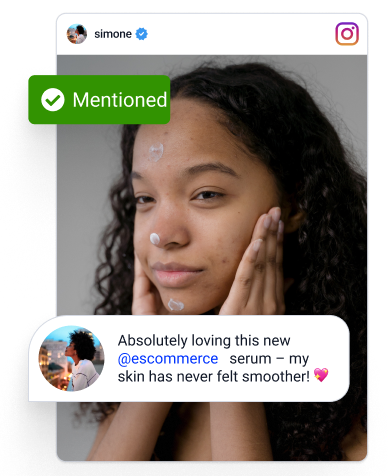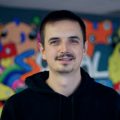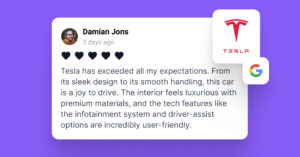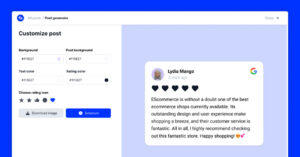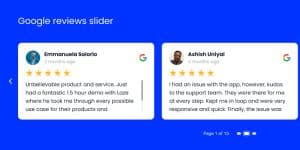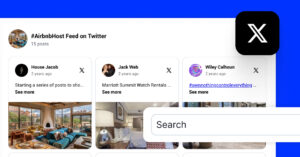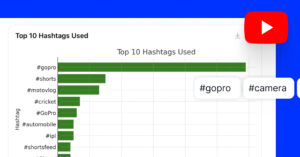Finding the right influencer can be a game-changer for your brand, as they boost your visibility, audience access, and social media reputation.
But with so many platforms, niches, and fake followers out there, how do you find influencers you can trust today, and how do you recognize their impact?
Should you search manually? Use an influencer marketing tool? Or wait for influencers and/or creators to tag you on social media?
I’ll tell you exactly how to find influencers in 2025, with practical methods, smart tools, and proven ways to turn those connections into long-term collaborations.
Let’s dive in.
What are influencers, and how do they differ from creators?
Influencers are individuals who have built a dedicated audience around a specific niche—fashion, fitness, travel, tech, you name it.
They’ve earned trust from their followers, which gives them the power to shape opinions and drive the decision-making process through content.
Content creators, on the other hand, are more focused on producing content—videos, photos, stories, tutorials—often driven by craft, creativity, or passion.
So, while all influencers are creators, not all creators aim to influence.
If your goal is brand awareness or product promotion, you’re probably looking for influencers. But if you’re seeking authentic content you can repurpose, you might want to collaborate with creators who love your product, even if they don’t have a following.
Knowing the difference helps you find the right fit.
Why finding the right influencers matters more than ever?
Influencer marketing is no longer about chasing vanity metrics—it’s about finding creators who align with your values and drive real results.
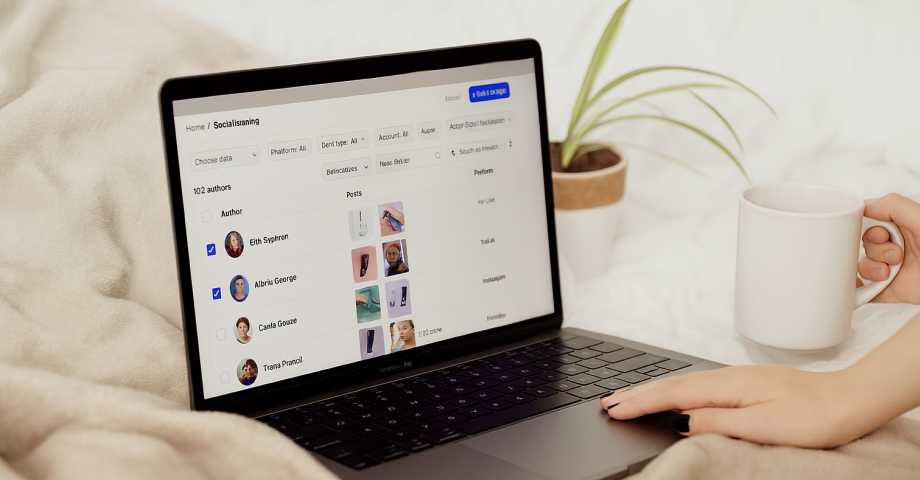
- Build stronger brand trust with authentic voices – people trust peers and creators more than traditional ads;
- Increase engagement with content that feels native – influencers know how to speak their audience’s language;
- Tap into niche communities you can’t reach alone – the right influencer already has access to your ideal customer;
- Create reusable content for multiple channels – influencer-generated content can become a reel, ad, testimonial, or website UGC block;
- Boost conversions with strategic influencer collaboration – followers are more likely to take action when they see a trusted face using your product.
Remember: choosing the right partner is essential to standing out online.
How to find influencers for your brand: 7 effective methods
Here are 7 proven methods that take out the guesswork out of finding quality influencers for your brand, regardless of your niche, platform, or budget:
1. Use influencer discovery tools to filter by platform, niche, and audience
These platforms let you search for influencers based on follower count, location, engagement rates, hashtags, and audience demographics like age, gender, and interests.
They’re ideal if you want to scale your outreach efficiently or focus on a specific type of creator who aligns with your brand.
For instance, here’s BuzzSumo’s ‘Influencers’ section showcasing info such as articles published, engagement metrics, top content, etc.:
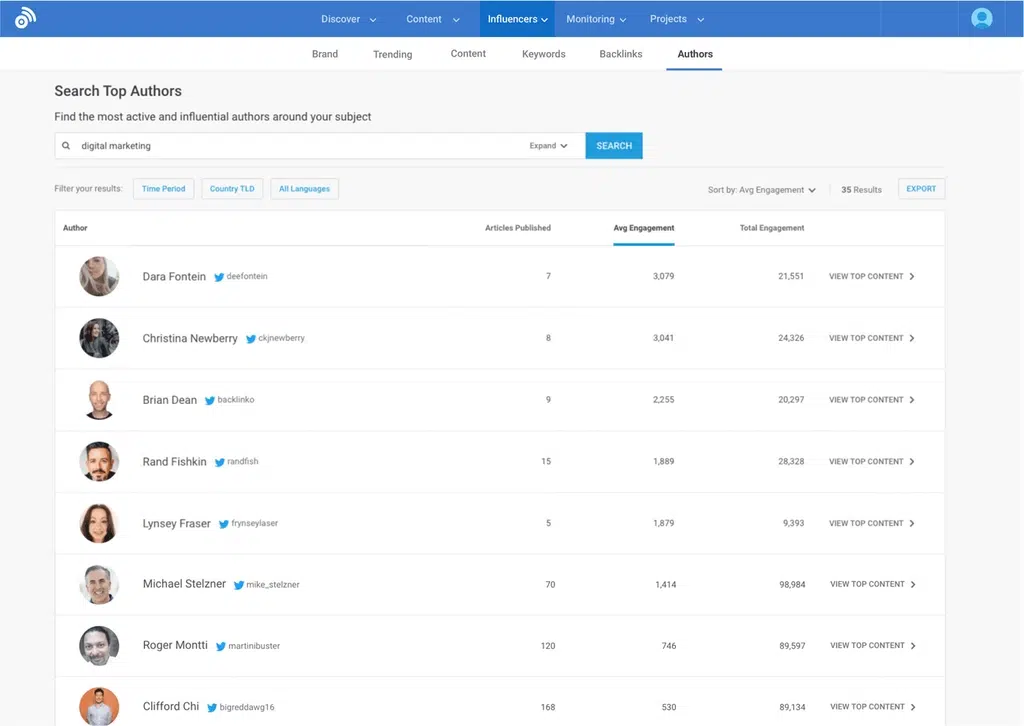
Pro tip: Look for tools that offer audience authenticity scores to avoid fake followers and bots.
2. Leverage social listening to find influencers already talking about your brand
Social listening tools like EmbedSocial let you track brand mentions, keywords, or hashtags in real time. You’ll uncover influencers who are already organically engaging with your product or space, which will make your outreach efforts much easier.
Here’s how that looks when tracking a hashtag via EmbedSocial:
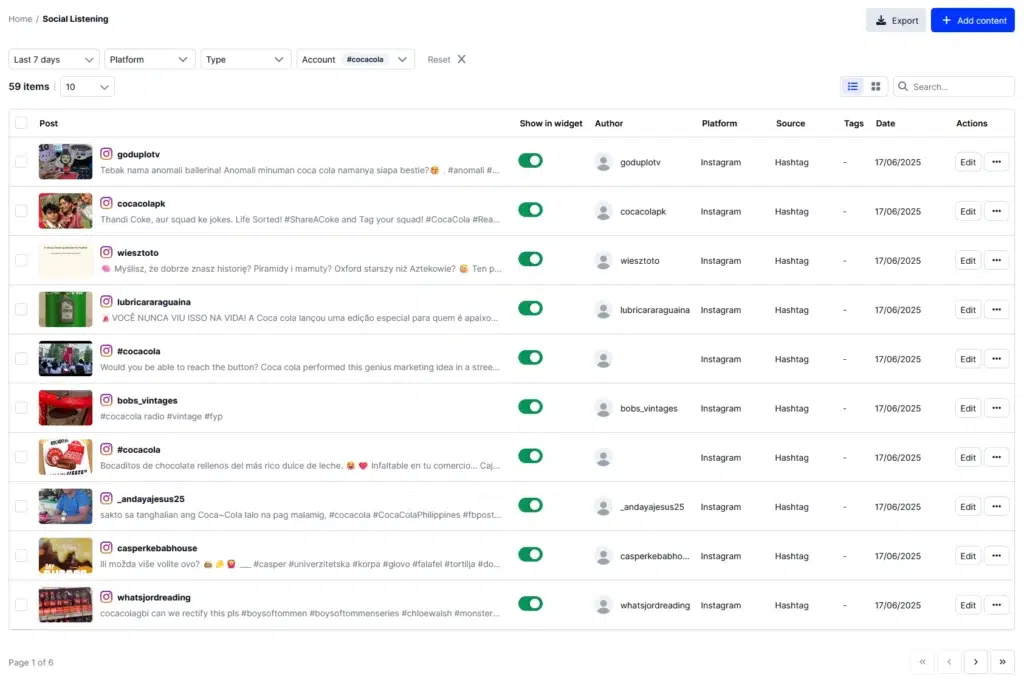
Pro tip: Prioritize influencers who already post about your industry—these partnerships tend to feel more authentic and perform better.
3. Search directly on social media platforms
You can start with Instagram, TikTok, or YouTube. Use simple keyword and hashtag searches to spot creators posting content in your niche. Then, check their engagement rate, follower quality, and brand alignment before reaching out.
Here’s how to do a simple hashtag search on Instagram:
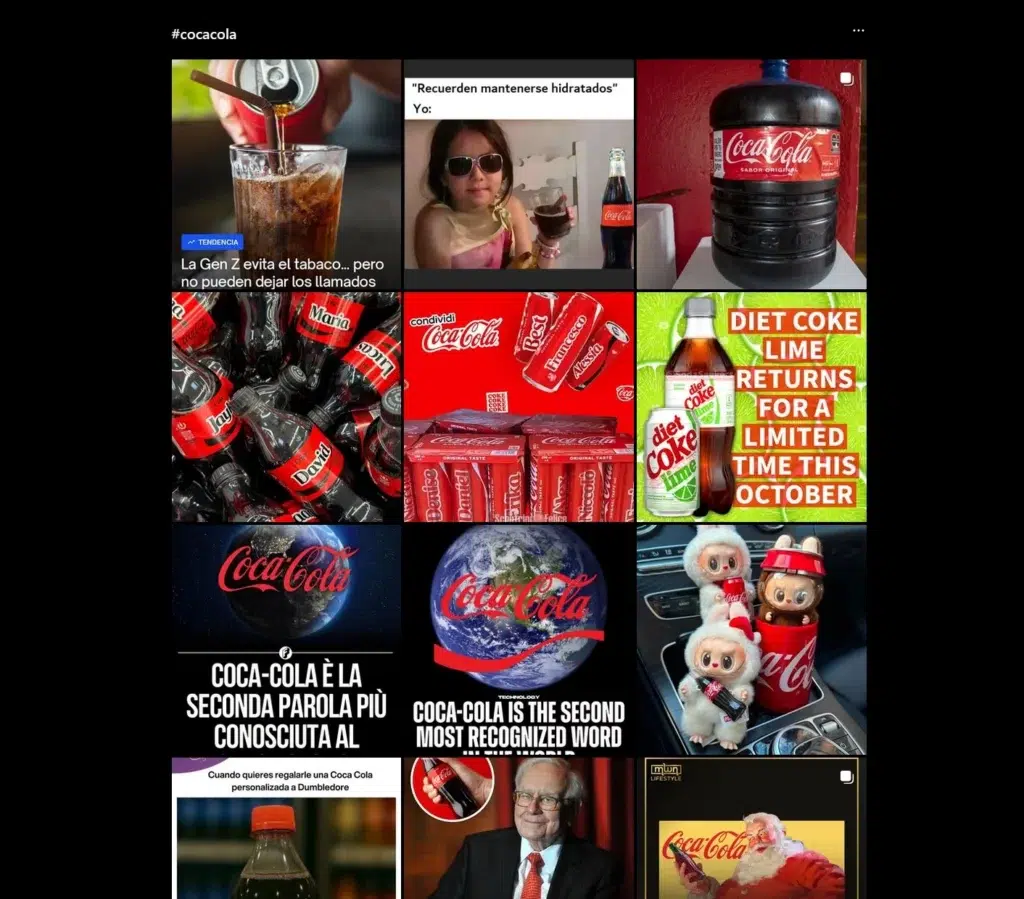
Pro tip: Use the “Tagged” section on Instagram profiles to find posts where others have featured them—it’s a great way to spot hidden gems.
4. Tap into your customer base to find brand advocates
Your best influencers may already be your customers. Check your customer list, subscribers, or followers for creators who already love your product.
Pro tip: Use tools like Upfluence or EmbedSocial to cross-reference customer data with influencer metrics and uncover hidden gems already in your ecosystem.
5. Explore influencer marketplaces and creator networks
Platforms like Aspire, Influencity, and Upfluence give you access to a massive influencer database where you can filter creators by niche, location, engagement, and more:
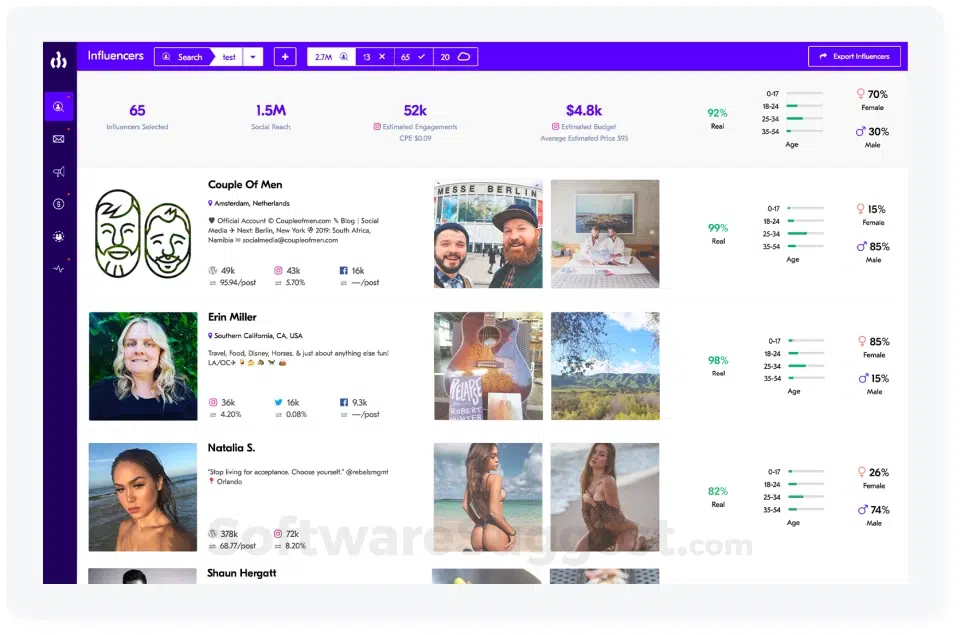
Pro tip: Many of these platforms offer influencer CRM tools—use them to track conversations and build long-term relationships.
6. Use YouTube search to find relevant creators
If you’re wondering how to find YouTube influencers, start with keyword searches related to your product or niche. Look at subscriber count, video views, and engagement—especially in the comments underneath the video (number of comments).
How to find relevant influencers? Here’s Coca-Cola’s YouTube hashtag page, for example, and you just need to open individual videos and see who created them:
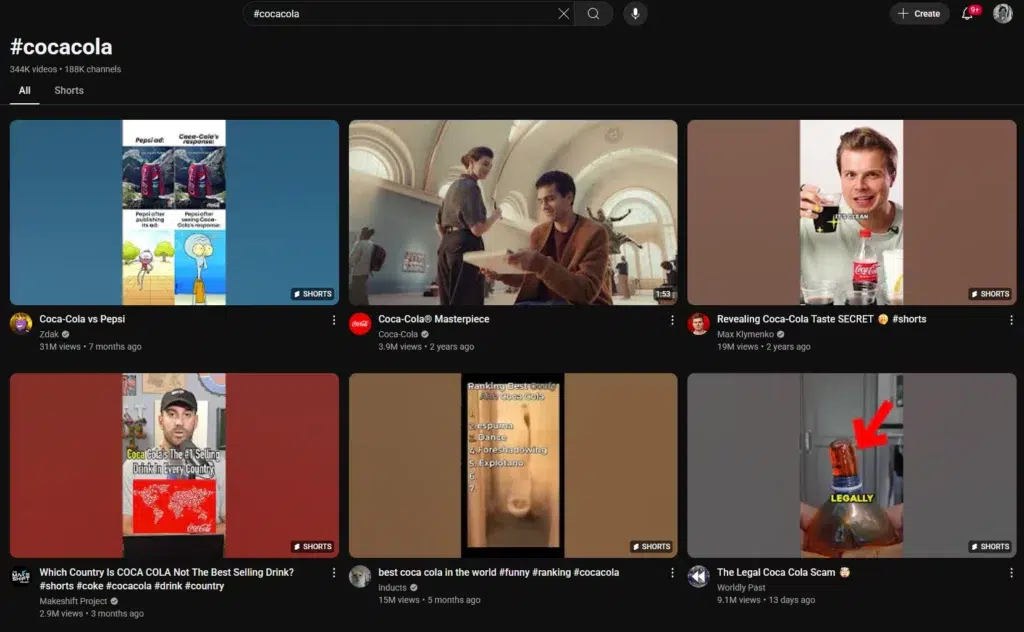
Pro tip: Filter by “This month” or “This week” to find active creators who are still consistently posting.
7. Join niche communities and creator groups
Influencers often hang out in private communities—like Facebook Groups, Discord servers, or even Slack channels—related to their niche. These spaces are perfect for connecting with authentic creators before they hit mainstream discovery tools.
For instance, here’s one of the largest Discord servers about wristwatches, and if you were operating in that niche, you would want to be part of it:
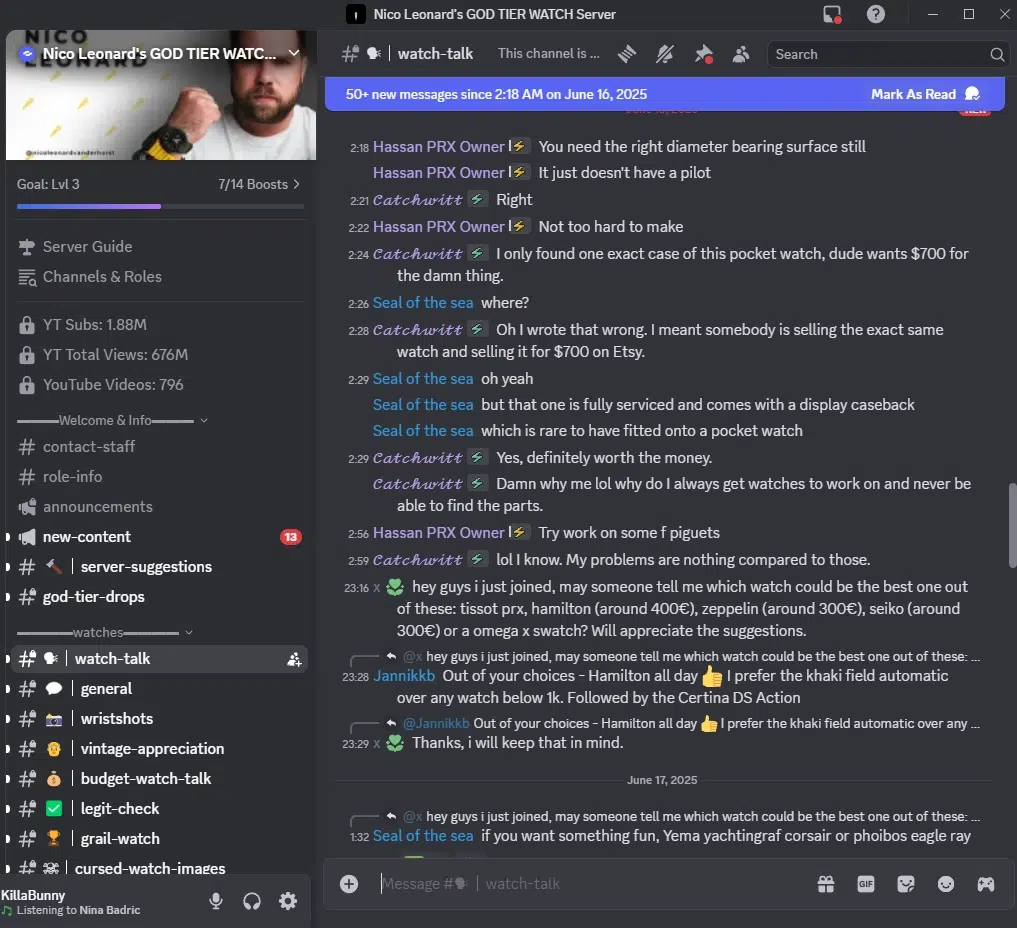
Pro tip: Look for niche-specific groups (e.g. “clean beauty creators” or “indie booktokers”) and observe who’s leading discussions or consistently creating content.
How to find influencers in your niche with a social listening tool
Finding relevant global or local influencers is easy with EmbedSocial’s social listening and analytics tools. Here’s how to do it from start to finish:
Step 1: Sign up and log in to your EmbedSocial account
Start by creating a new EmbedSocial account – it only takes a few minutes and comes with a 7-day free trial. Once signed in, you’ll be ready to start tracking influencers across platforms.
Step 2: Connect your social media sources
Go to ‘Sources’ → ‘Add new source’ (top-right corner).
To effectively discover influencers, we recommend connecting the following sources:
- Instagram: hashtags, account mentions, and usernames
- TikTok: trending hashtags and keyword-based discovery
- X (formerly Twitter): keywords, hashtags, and mentions
- YouTube: hashtag-based content
Choose the most relevant input based on your niche, such as branded hashtags, industry keywords, or competitor mentions.
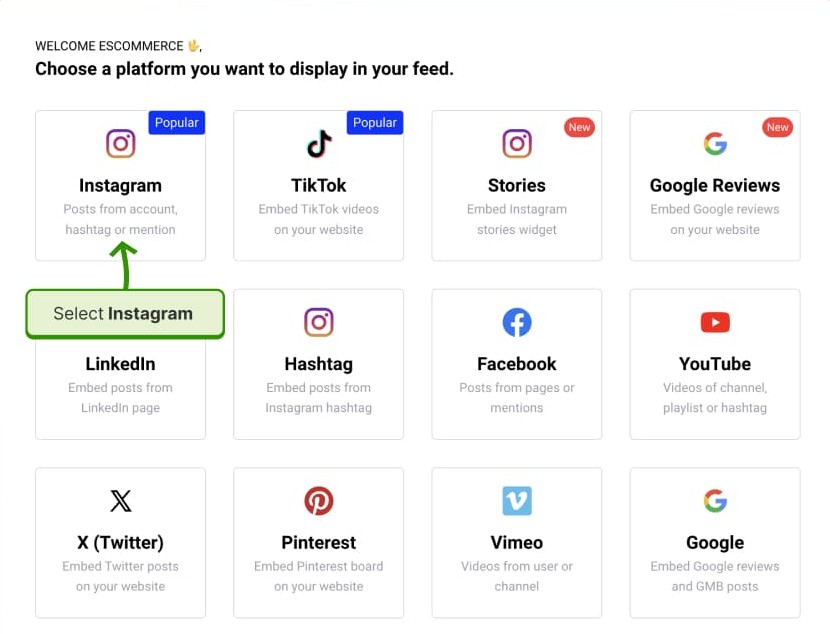
Step 3: Monitor and identify influencers
Once your sources are connected, go to the ‘Monitor’ section. Here’s where the influencer discovery happens:
- Use filters to sort posts by account name, engagement, or keyword
- Focus on repeat appearances of accounts or those with strong engagement metrics
- Click on an account to view their profile, post history, and platform presence
- Use the Tags feature to group and label these potential influencers (e.g., Micro-influencer, Brand fit, High engagement)
This step turns raw data into a shortlist of influencer prospects.
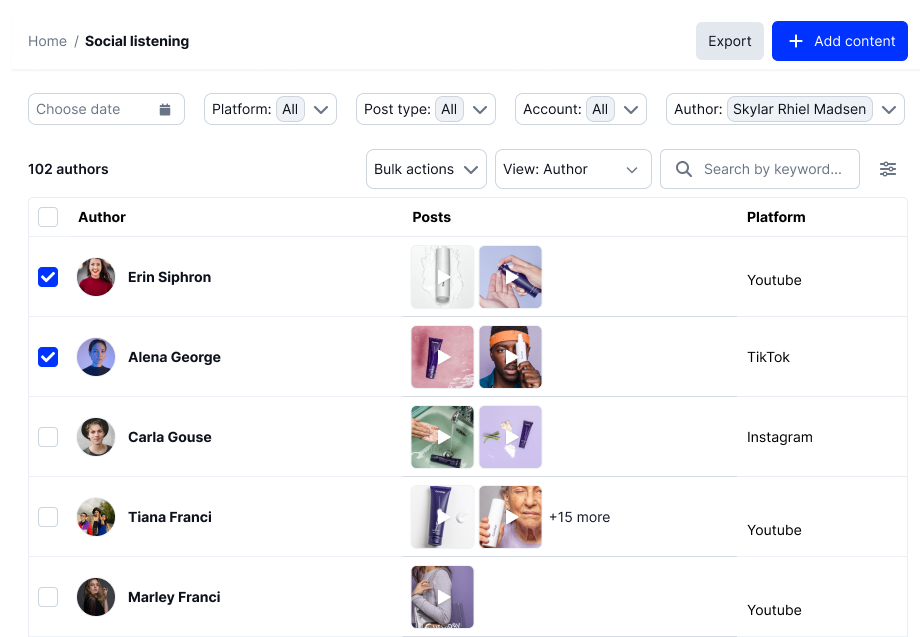
Step 4: Export influencer data
Click the ‘Export’ button in the top-right corner to download your filtered data. Use filters to include only relevant influencer posts or profiles. The export will help you further review and enrich this data in external tools like Clay or your CRM.
Pro Tip: Once you’ve identified key influencer accounts, add them as recurring sources to continue tracking their content and mentions over time—so you’re always updated with their latest activity.
Step 5: Analyze content patterns with the ‘Analytics’ tool
Navigate to the ‘Analytics’ section and upload your exported .csv file.
The system will reveal insights such as:
- Top-performing hashtags and keywords
- Most mentioned accounts (potential influencers)
- Influencer segmentation by platform and content type
- Sentiment around their posts
These insights help you decide who is truly influential in your niche and worth reaching out to.
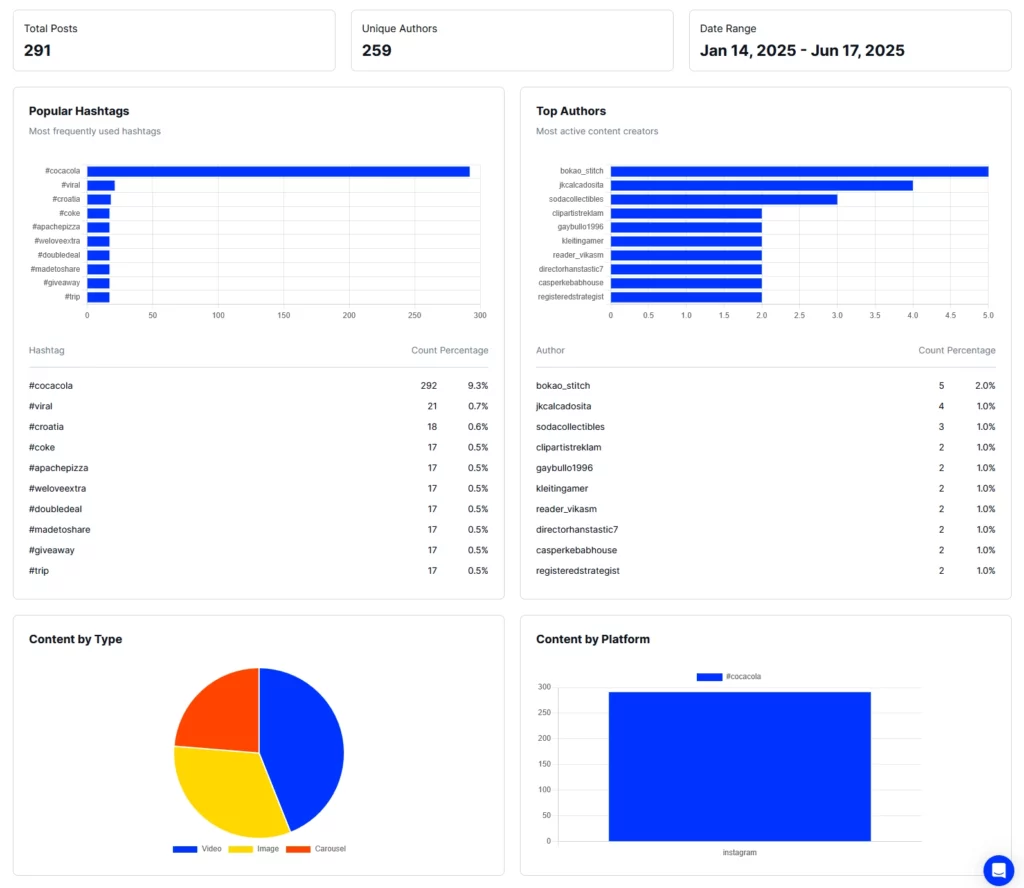
In this case, you can quickly identify potential influencers by looking at the ‘Top Authors’ box.
From outreach to ongoing partnerships: 5 influencer collaboration ideas
Finding influencers is just step one. You must manage influencer relationships that turn into authentic, results-driven influencer marketing campaigns built on trust and great content.
To help you do that, here are 5 collaboration tips:
Personalize your influencer collaboration email
Skip the generic “Hey [influencer name]” outreach. Mention their content, why you picked them, and what your brand is about.
Example:
“Hi [First Name], I loved your recent video on [Topic] that I saw on [Platform]. Your tone and creativity are exactly what we’re looking for at [Brand Name]. We’d love to collaborate with you on a short-form UGC campaign—interested?”
Offer creative freedom—but set clear guidelines
Give influencers room to create content in their own voice. Just make sure to set clear goals (e.g., feature the product, mention your CTA, keep it brand-safe).
Pro tip: Create a simple one-pager with brand voice, visual dos/don’ts, and deliverables.
Collaborate on content formats that go beyond product posts
Think beyond the basic shoutout. Try the following:
- Behind-the-scenes videos – perfect for Instagram Stories or Reels;
- Day-in-the-life vlogs – great for YouTube and TikTok;
- Giveaways or challenges – high engagement + new followers;
- Collaborative carousels or quotes – great for LinkedIn or Instagram.
Turn influencer UGC into long-term brand assets
Once a campaign wraps, organize all your social media content, and then reuse it. Add it to your product pages, email newsletters, paid ads, or testimonials.
Pro tip: Tools like EmbedSocial make this easy by automatically pulling influencer UGC, which you can then embed on your website or anywhere else you’d like.
Keep track and nurture your best influencer relationships
Use influencer discovery tools or spreadsheets for influencer relationship management—track engagement, click-throughs, brand mentions, and re-engage top performers for future campaigns.
Pro tip: Consider building an exclusive “brand creator circle” with early access to product launches, affiliate bonuses, or long-term perks.
10 effective methods for finding influencers and boosting brand success by experts
Here’s what 10 thought leaders had to say on this exact issue:
- Social Listening Tools Reveal Perfect Influencer Matches
- LinkedIn Creator Search Finds Trusted B2B Voices
- Influencer Platforms Deliver Data-Driven Partnership Success
- Hashtag Searches Uncover Authentic Industry Voices
- Users Become Influencers Through Cash-Back Sharing
- Micro-Influencers Drive Results Through Authentic Connections
- Analytical Approach Pairs Brands With Perfect Influencers
- Niche Events Connect Brands With Trusted Voices
- B2B Bloggers Build Trust Beyond Traditional Influencers
- Data-Focused Strategy Targets Audience Over Follower Count
1. Social Listening Tools Reveal Perfect Influencer Matches
Use Social Listening Tools
One of the best ways we’ve found influencers is through social listening using tools like Sprout Social. What makes it so effective is that you’re not guessing, you’re actually seeing who’s already talking about your industry, competitors, or key terms that matter to your audience. Instead of cold-searching hashtags or browsing random profiles, we let the data tell us who’s creating meaningful content that’s getting engagement.
A real example was when we were launching a new feature for field service businesses, and Sprout picked up on a small fleet operations consultant on LinkedIn and Twitter who had just posted a thread on productivity in the trades. He wasn’t a huge influencer, but his audience was right on target: owners and managers of small service teams. We reached out, sent over early access, and he later included us in a tools roundup that brought a noticeable spike in traffic and demo requests.
It’s important not to just look at follower counts, but also at relevance, engagement, and tone. With Sprout, we could filter by sentiment and even identify people who mentioned our brand without tagging us. That opened the door to more partnerships that felt natural, not forced. It’s one of the most organic ways to find influencer fits that move the needle.
Sara Cooper, Director of Web Strategy, BigChange
2. LinkedIn Creator Search Finds Trusted B2B Voices
Using LinkedIn Creator and Influencer Search
One of the most effective ways we’ve found influencers is by using LinkedIn’s Creator and Influencer search to go beyond traditional platforms like Instagram or TikTok. Unlike other networks, LinkedIn gives you access to professionals who have built trusted audiences around business, leadership, HR, or niche B2B topics, which works perfectly for us since we partner with a lot of people, teams, and sales leaders.
One method we’ve used is filtering by job title, like “Chief People Officer” or “Employee Engagement Consultant”, and then checking who regularly posts or comments with authority on workplace culture, recognition, or gifting. These folks may not label themselves as influencers, but they have serious pull with their audiences.
For example, we found a workplace consultant who had under 10K followers but got amazing engagement on every post. After partnering with her for a co-branded LinkedIn Live and a gifting campaign, we saw a noticeable spike in inbound demo requests that week, especially from HR decision-makers. It wasn’t about follower count; it was about trust and alignment.
So my advice is not to just look for hashtags or viral posts. Use LinkedIn search to find the voices your target audience already listens to. It’s slower than a marketplace tool but much more strategic.
Elad Maoz, Chief Partnerships Officer, gifted.co
3. Influencer Platforms Deliver Data-Driven Partnership Success
Using Influencer Marketing Platforms
Using an influencer marketing platform like Influencity has made it easier for us to find and manage partnerships. Before we used it, we spent hours manually searching Instagram and YouTube for creators who “seemed” like a good fit. But using influencer marketing platforms has made everything a lot easier, since we can filter by niche, audience location, engagement rate, and even device usage, which is crucial for a product like ours.
One campaign was for our productivity app, where we found mid-tier tech influencers with a strong Android user base in Europe. We collaborated with three of them to create short tutorials and review videos. The content felt authentic, and we saw a 22% bump in downloads in just two weeks after the posts went live. What helped most was that using this influencer marketing platform didn’t just show follower counts, it gave us engagement data and audience quality, which made our choices smarter. It’s not just about finding influencers; it’s about finding the right ones. That’s what made the real difference.
Adrian Nikolov, Head of Content Maketing & SEO, MobiSystems
4. Hashtag Searches Uncover Authentic Industry Voices
Searching Relevant Hashtags on Social Media
One of the most effective ways we’ve found influencers is by searching relevant hashtags directly on social media, especially on LinkedIn and Instagram. We were looking to promote a data privacy solution aimed at mid-size tech companies, so we started searching hashtags like #dataprivacy, #compliance, and #privacybydesign. What worked best was finding micro-influencers, people with smaller but highly engaged audiences who regularly posted thoughtful takes on industry regulations or data ethics.
We found a privacy consultant on LinkedIn through the hashtag #GDPR, who had a loyal following of CISOs and tech leads. She wasn’t a “traditional” influencer, but she had trust in the community. We reached out, offered a free trial of our product, and partnered on a short-form video series. Her audience responded well, our site traffic from LinkedIn jumped 30% that week, and we booked three demos directly from her referral link.
The best part about using hashtags is that it feels more organic. You’re tapping into real conversations, not just sponsored content. It’s an underrated but powerful way to find authentic voices who truly connect with your niche.
Colleen Barry, Head of Marketing, Ketch
5. Users Become Influencers Through Cash-Back Sharing
We didn’t have to look far for great influencers – they were already using our platform. Our “Pays-2-Share” program transforms coupon lovers into amazing micro-influencers. Users earn cash back, up to 2%, for sharing working coupons that result in a purchase.
One of our top contributors was a deal blogger who drove thousands of dollars every month. We never pursued these influencers in the traditional sense. We simply turned people with a passion for savings into influencers. This was much more effective than any influencer outreach campaign.
Gary Gray, CEO, CouponChief.com
6. Micro-Influencers Drive Results Through Authentic Connections
The best method I’ve used to find influencers is starting with micro-influencers who genuinely align with my brand’s values and audience. Instead of chasing follower counts, I look for those with high engagement and authentic content around healthy eating and wellness. For example, partnering with a local nutrition blogger who shared her personal experience with my meal plans led to a surge in inquiries and bookings. The key is building real relationships, offering value beyond just payment—like exclusive menus or personalized experiences. This approach feels genuine and yields lasting impact.
Keagan Stapley
Personal Chef & Business Owner
Keagan Stapley, Owner, NYC Meal Prep
7. Analytical Approach Pairs Brands With Perfect Influencers
As the founder and CEO of Omniconvert, my method for identifying influencers has always been analytical and deliberate. One of the most effective strategies I’ve employed is utilizing specialized platforms for influencer marketing that assess metrics like interaction rates, audience profiles, and content alignment. That said, relying solely on tools isn’t enough; I make it a priority to personally review an influencer’s principles and authenticity to ensure they resonate with my brand’s mission.
For instance, while launching a new eCommerce feature, I partnered with a micro-influencer whose followers included aspiring online entrepreneurs eager to master retention tactics. This collaboration enhanced our reach and led to a 15% rise in demo sign-ups. Building connections is another essential aspect—I’ve engaged with influencers through industry meetups and even LinkedIn, which often results in more genuine partnerships. Maintaining honesty about my brand’s purpose and objectives helps influencers feel truly invested in the initiatives. By employing this strategy, I’ve supported businesses in exchanging value more efficiently and fostering meaningful connections with their audiences, all while achieving tangible, measurable outcomes.
Valentin Radu, CEO & Founder, Blogger, Speaker, Podcaster, Omniconvert
8. Niche Events Connect Brands With Trusted Voices
One of the best ways I’ve found influencers for our spiritual platform was through in-person meet-ups and niche industry events. At a numerology conference in Istanbul, I met a tarot reader who had a small but engaged following on YouTube. She wasn’t someone you’d find on typical influencer lists, but her audience trusted her. We collaborated on a short video series that introduced our platform’s live readings, and within a week, we saw a 12% increase in new user signups.
Another method that’s worked well is using manual Instagram hashtag research. I searched hashtags like #energyhealing, #spiritualcoaching, and #chakraalignment, then looked for people who didn’t just post pretty content, but actually shared their own stories or client transformations. Those are the ones who convert because they connect. It’s not quick, but it’s effective.
Amy Bos, Co-Founder & COO, Mediumchat Group
9. B2B Bloggers Build Trust Beyond Traditional Influencers
Collaborating with Bloggers and Newsletter Writers
One of the most effective ways we’ve found influencers for our brand is by collaborating with bloggers and newsletter writers who already have a strong voice in the cloud and IT infrastructure space. These aren’t your typical Instagram influencers; they’re trusted subject matter experts who speak directly to our audience, which includes IT leaders, DevOps professionals, and CTOs.
One collaboration that stood out for us was with a well-known DevOps blogger who runs a weekly Substack read by thousands of engineering leaders. We partnered with him on a sponsored deep dive about hybrid cloud complexity, and rather than feeling like an ad, it read like a helpful, insider guide. We got a surge in demo requests that week, and even better, people were referencing that article in sales calls.
Another success was co-creating a technical walkthrough with a cloud-native security writer on Medium. He’d never heard of emma before, but after a few conversations and some hands-on access, he genuinely became an advocate. That piece not only performed well on SEO, but also earned us credibility in a very niche space.
What I love about this approach is that it doesn’t feel like “influencer marketing”; it feels like relationship building with people who already have their audience’s trust. And in B2B, that trust is everything.
Dirk Alshuth, CMO, emma
10. Data-Focused Strategy Targets Audience Over Follower Count
To find the right influencers, we focus on data and the audience rather than just looking at reach or follower counts.
Rather than using standard influencer platforms, we turned to tools like SparkToro and BuzzSumo. These helped us find niche influencers whose followers matched our target customers. By checking how much their audiences overlap with ours and examining engagement and relevant topics, we compiled a list of creators worth talking to.
For instance, when we launched our B2B software aimed at mid-sized service businesses, we teamed up with a LinkedIn creator who had fewer than 20,000 followers. This person had great engagement with operations leaders and small business owners. They shared a quick video demonstrating how to use our platform, followed by a step-by-step guide in a carousel post. The campaign exceeded our expectations.
Yaniv Masjedi, Chief Marketing Officer, Nextiva
5 influencer discovery tools to make the process easier
If you want to search influencers on a grander scale, using an influencer search tool can save you hours of manual work while helping you find the right creators faster. If you choose the right platform, you won’t even have to switch between different tools.
Here are some top influencer marketing platforms and discovery tools to try in 2025:
EmbedSocial – Best for finding influencers through social listening and UGC tracking
EmbedSocial lets you do social media listening for all types of brands and businesses in real time to discover influencers already talking about your brand, niche, or products.
It’s the best influencer search tool for spotting authentic creators and turning their posts into content you can use:
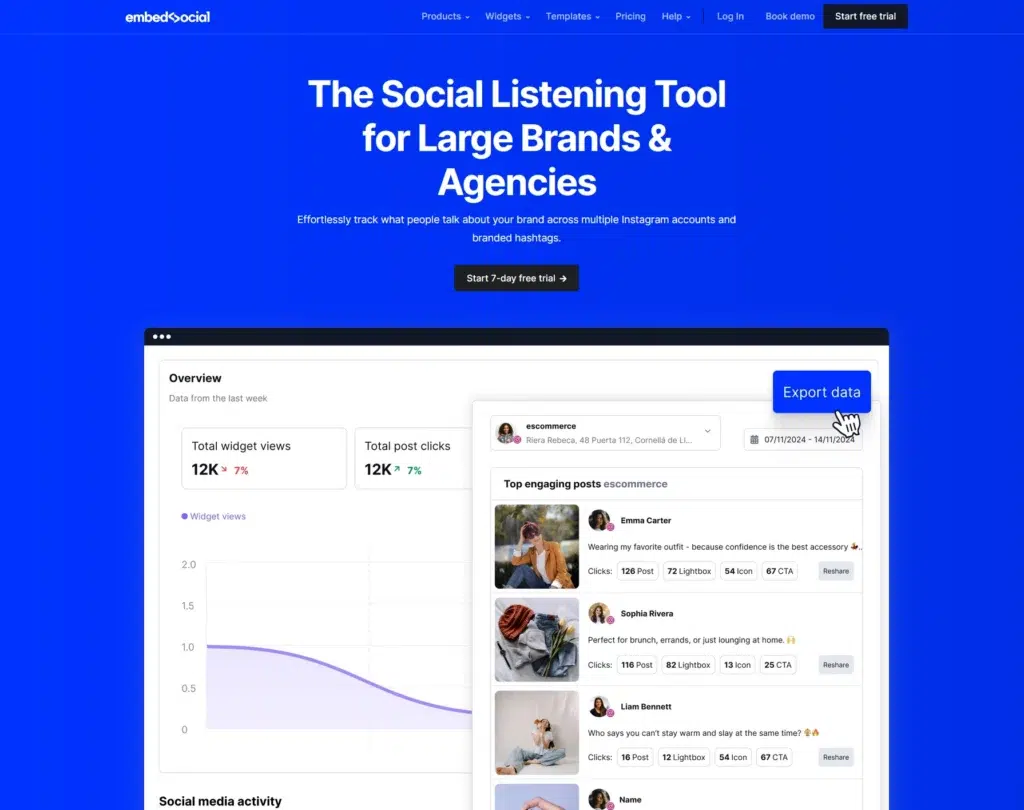
- Track mentions of your brand, hashtags, or keywords – see who’s already engaging with your space;
- Discover micro influencers organically – wondering how to find micro influencers? You can filter by platform and post type;
- Collect influencer-generated UGC automatically – influencer-generated content can be turned into widgets, carousels, or testimonials;
- Analyze the performance of influencer content – find out which creators drive clicks, views, or conversions.
BuzzSumo – Best for finding influencers by topic or content performance
BuzzSumo helps you discover influencers who are already publishing high-performing content in your niche. It’s ideal if you want to find thought leaders, bloggers, or journalists:
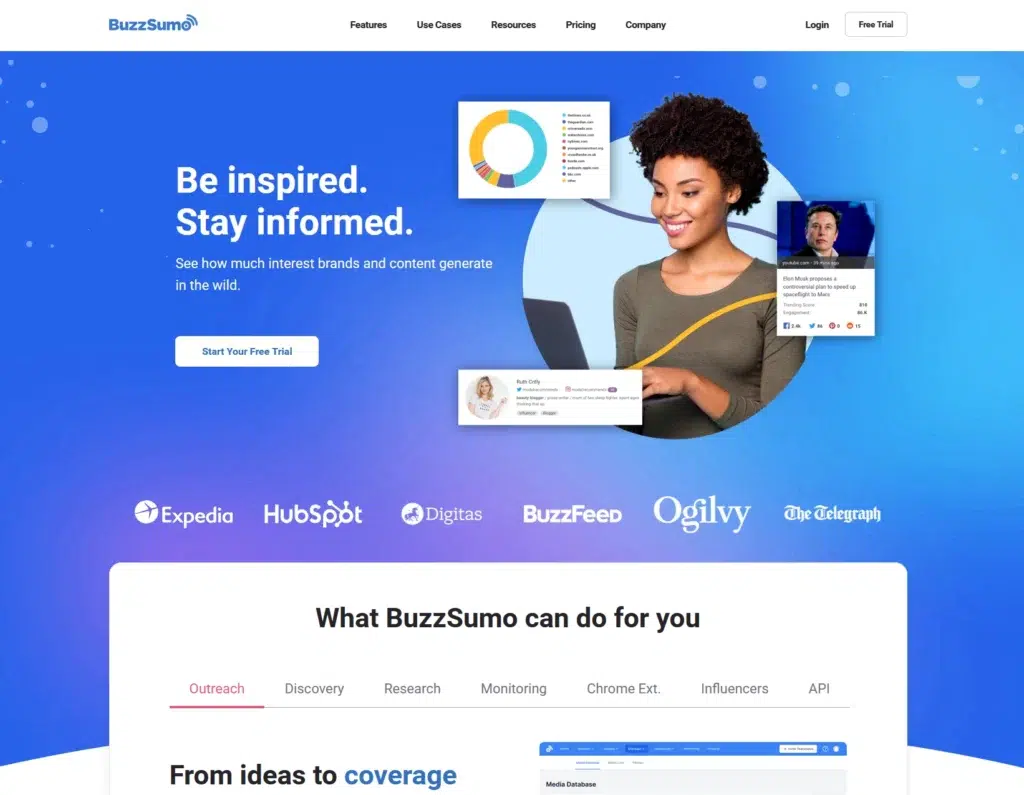
- Search by topic, keyword, or domain – instantly surface influencers by relevance;
- Analyze content engagement across channels – identify creators with real traction;
- Discover new influencers via backlinks and shares – see who drives the most links or mentions;
- Track influencers over time—monitor growth and performance in niche categories.
Upfluence – Best for eCommerce influencer discovery and campaign management
Upfluence is a full-suite influencer platform built for brands and online stores. It helps you manage everything from discovery to outreach to campaign tracking in one place:
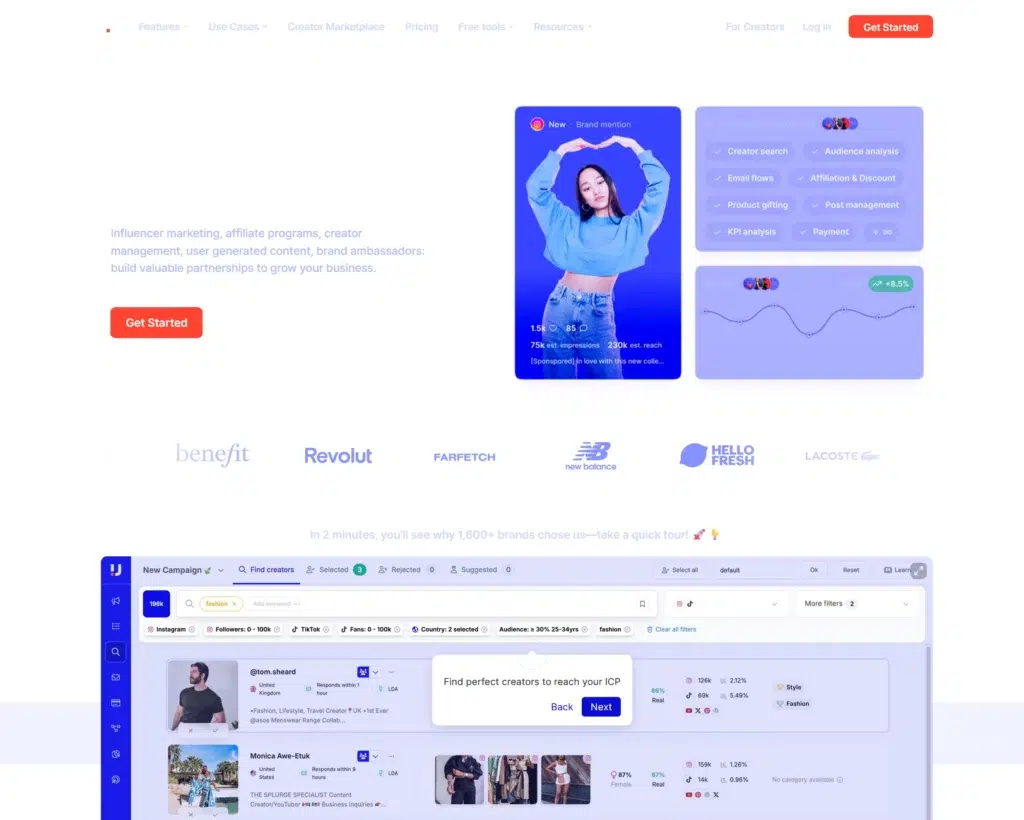
- Search for influencers by industry, demographics, or follower count – across Instagram, TikTok, YouTube, and more;
- Integrate with your eCommerce store – identify influencers already in your customer base;
- Send outreach emails directly from the platform – built-in influencer CRM;
- Track campaign performance and ROI – easily measure what’s working.
Sprout Social – Best for influencer discovery via social monitoring and audience insights
Sprout Social isn’t just a scheduling tool—it also includes powerful social monitoring features that can help you identify rising influencers or brand advocates in your space:

- Use social listening to spot influencer mentions and keywords across major platforms;
- Analyze target audience sentiment and engagement – see who’s driving positive buzz;
- Tag and organize influencers in your dashboard – track your outreach efforts;
- Integrate with publishing workflows – sync influencer UGC with your social content plan.
Flowbox – Best for finding and managing influencer UGC at scale
Flowbox focuses on collecting and showcasing user-generated content from influencers and customers. It’s especially useful for e-commerce brands looking to source and reuse authentic product content:
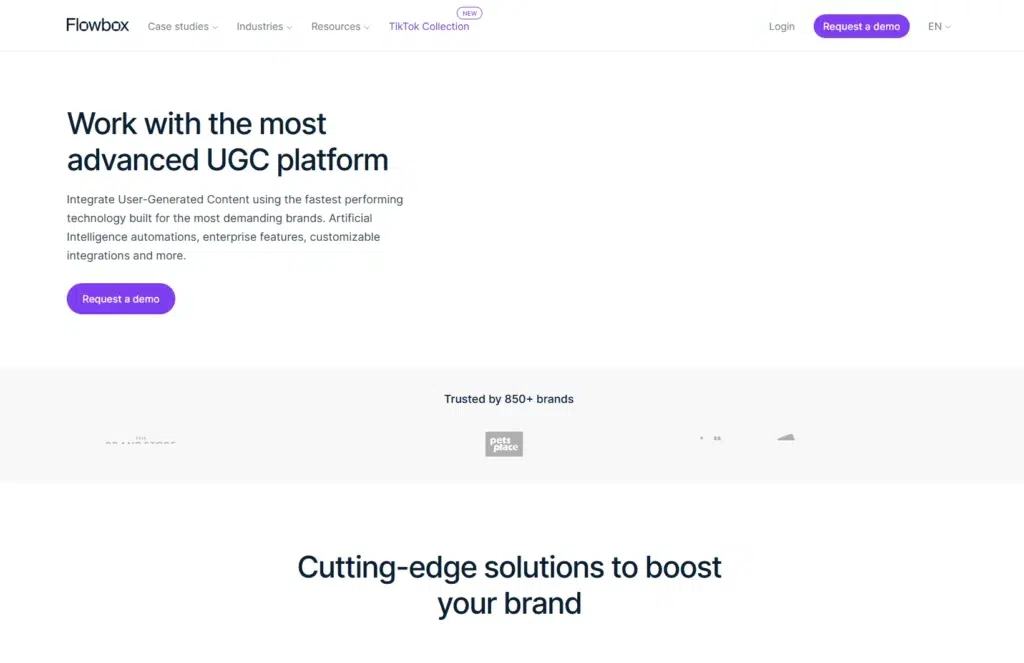
- Discover influencers by analyzing UGC submissions and brand tags across Instagram and other channels;
- Request UGC rights directly from creators – streamline legal approvals;
- Display influencer content in beautiful galleries and widgets – on product pages or social feeds;
- Measure engagement and conversions from UGC – track performance on-site.
Conclusion: Start finding the right influencers to grow your brand!
You don’t need a massive budget or a celebrity name to win with influencer marketing. You need the right influencer marketing tools.
Then, just use the proper discovery method for your niche, outreach, and tools to build strong, authentic partnerships.
Ultimately, whether you’re just starting out or scaling a complete UGC strategy, these methods will help you find ambassadors who truly fit your brand.
Ready to turn those connections into content, trust, and growth? Let’s go.
Ready to discover influencers already talking about your brand?
Try EmbedSocial’s social listening tool and turn mentions into meaningful collaborations.
FAQs on how to find influencers and collaborate effectively
How to find influencers for your brand?
Start by identifying your ideal audience and platform, then use influencer discovery tools, do social listening, monitor hashtags, or contact your own customer base to find creators who align with your brand values and voice.
What is the best influencer discovery tool?
The best tool depends on your goals—EmbedSocial is great for social listening and UGC tracking, while platforms like Modash or Upfluence offer advanced filtering and campaign management.
What are the 3 R’s of influencer marketing?
The 3 R’s stand for Reach, Relevance, and Resonance—focus on finding influencers who not only have followers but also align with your brand and create content that truly connects.
Is there a free tool for finding influencers?
Yes, platforms like EmbedSocial, BuzzSumo, and Modash offer free trials or limited features to help you explore influencers by topic, while manual methods like hashtag search cost nothing but time.
What is the best tool for finding influencers?
Tools like EmbedSocial, Upfluence, and BuzzSumo each have unique strengths—choose based on whether you need discovery, social listening, outreach, or UGC integration.
How do I find micro influencers?
Search by niche hashtags, check who’s tagging your brand, or use filters in discovery tools to narrow results by follower count—micro influencers usually have 1,000 to 100,000 loyal followers.
What’s the best way to collaborate with influencers?
Start with a personalized pitch, offer creative freedom with clear guidelines, and build a relationship that can grow into ongoing content partnerships, not just one-off posts.
Can I use UGC from influencer campaigns?
Yes—just be sure to get permission or usage rights. Tools like EmbedSocial make it easy to collect, organize, and showcase influencer UGC across your website, emails, and ads.
